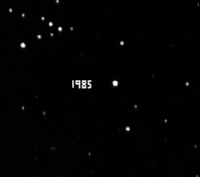
Extrasolar planets and brown dwarfs around AF-type stars - IX. The HARPS southern sample
Sign Up to like & getrecommendations! Published in 2017 at "Astronomy and Astrophysics"
DOI: 10.1051/0004-6361/201628805
Abstract: Context. Massive, main-sequence (MS) AF-type stars have so far remained unexplored in past radial velocities (RV) surveys due to their small number of spectral lines and high rotational velocities that prevent the classic RV computation… read more here.
Keywords: occurrence; day period; type stars; day ... See more keywords

The GAPS Programme with HARPS-N at TNG XIII. The orbital obliquity of three close-in massive planets hosted by dwarf K-type stars: WASP-43, HAT-P-20 and Qatar-2
Sign Up to like & getrecommendations! Published in 2017 at "Astronomy and Astrophysics"
DOI: 10.1051/0004-6361/201629720
Abstract: Context. The orbital obliquity of planets with respect to the rotational axis of their host stars is a relevant parameter for the characterization of the global architecture of planetary systems and a key observational constraint… read more here.
Keywords: dwarf type; wasp hat; obliquity; hat qatar ... See more keywords

Effective temperature determinations of late-type stars based on 3D non-LTE Balmer line formation
Sign Up to like & getrecommendations! Published in 2018 at "Astronomy and Astrophysics"
DOI: 10.1051/0004-6361/201732546
Abstract: Hydrogen Balmer lines are commonly used as spectroscopic effective temperature diagnostics of late-type stars. However, reliable inferences require accurate model spectra, and the absolute accuracy ... read more here.
Keywords: effective temperature; balmer; late type; type stars ... See more keywords

Detection of new O-type stars in the obscured stellar cluster Tr 16-SE in the Carina Nebula with KMOS
Sign Up to like & getrecommendations! Published in 2021 at "Astronomy and Astrophysics"
DOI: 10.1051/0004-6361/202039620
Abstract: The Carina Nebula harbors a large population of high-mass stars, including at least 75 O-type and Wolf-Rayet stars, but the current census is not complete since further high-mass stars may be hidden in or behind… read more here.
Keywords: type stars; high mass; carina nebula;

Binary fraction of O and B-type stars from LAMOST data
Sign Up to like & getrecommendations! Published in 2021 at "Research in Astronomy and Astrophysics"
DOI: 10.1088/1674-4527/21/11/272
Abstract: Binary stars play an important role in the evolution of stellar populations . The intrinsic binary fraction (f bin) of O and B-type (OB) stars in LAMOST DR5 was investigated in this work. We employed… read more here.
Keywords: fraction type; type stars; stars lamost; binary fraction ... See more keywords

Unveiling the initial conditions of open star cluster formation
Sign Up to like & getrecommendations! Published in 2023 at "Research in Astronomy and Astrophysics"
DOI: 10.1088/1674-4527/acd58d
Abstract: Open clusters (OCs) are infrequent survivors of embedded clusters gestated in molecular clouds. Up to now, little is known about the initial conditions for the formation of OCs. Here, we studied this issue using high-precision… read more here.
Keywords: conditions open; type stars; star cluster; unveiling initial ... See more keywords

A spectroscopic test of the rotational modulation origin of periodic Kepler photometric variability of A-type stars
Sign Up to like & getrecommendations! Published in 2020 at "Monthly Notices of the Royal Astronomical Society"
DOI: 10.1093/mnras/staa2444
Abstract: High-precision space-based photometry obtained by the \emph{Kepler} and \emph{TESS} missions has revealed evidence of rotational modulation associated with main sequence (MS) A and late-B type stars. Generally, such variability in these objects is attributed to… read more here.
Keywords: kepler; variability; type; type stars ... See more keywords

Superflares and variability in solar-type stars with TESS in the Southern hemisphere
Sign Up to like & getrecommendations! Published in 2020 at "Monthly Notices of the Royal Astronomical Society"
DOI: 10.1093/mnras/staa923
Abstract: Superflares on solar-type stars have been a rapidly developing field ever since the launch of Kepler. Over the years, there have been several studies investigating the statistics of these explosive events. In this study, we… read more here.
Keywords: type stars; solar type; southern hemisphere; superflares variability ... See more keywords

X-ray properties of early-type stars in the Tarantula Nebula from T-ReX
Sign Up to like & getrecommendations! Published in 2022 at "Monthly Notices of the Royal Astronomical Society"
DOI: 10.1093/mnras/stac1952
Abstract: We reassess the historical LX/LBol relation for early-type stars from a comparison between T-ReX, the Chandra ACIS X-ray survey of the Tarantula Nebula in the Large Magellanic Cloud (LMC), and contemporary spectroscopic analysis of massive… read more here.
Keywords: tarantula nebula; ray; stars tarantula; lbol ... See more keywords

Non-LTE line formation of Fe in late-type stars – IV. Modelling of the solar centre-to-limb variation in 3D
Sign Up to like & getrecommendations! Published in 2017 at "Monthly Notices of the Royal Astronomical Society"
DOI: 10.1093/mnras/stx673
Abstract: Our ability to model the shapes and strengths of iron lines in the solar spectrum is a critical test of the accuracy of the solar iron abundance, which sets the absolute zero-point of all stellar… read more here.
Keywords: non lte; line formation; lte line; formation late ... See more keywords

Characterization of the radial velocity signal induced by rotation in late-type dwarfs
Sign Up to like & getrecommendations! Published in 2017 at "Monthly Notices of the Royal Astronomical Society"
DOI: 10.1093/mnras/stx771
Abstract: We investigate the activity induced signals related to rotation in late type stars (FGKM). We analyse the Ca II H&K, the H alpha and the radial velocity time-series of 55 stars using the spectra from… read more here.
Keywords: rotation late; velocity; radial velocity; late type ... See more keywords